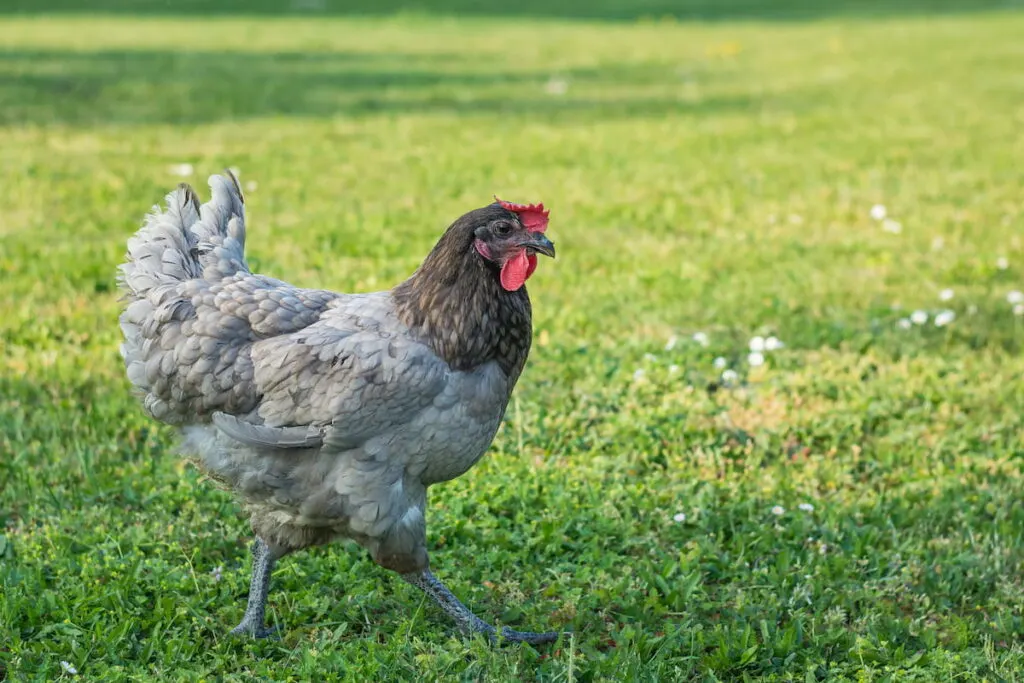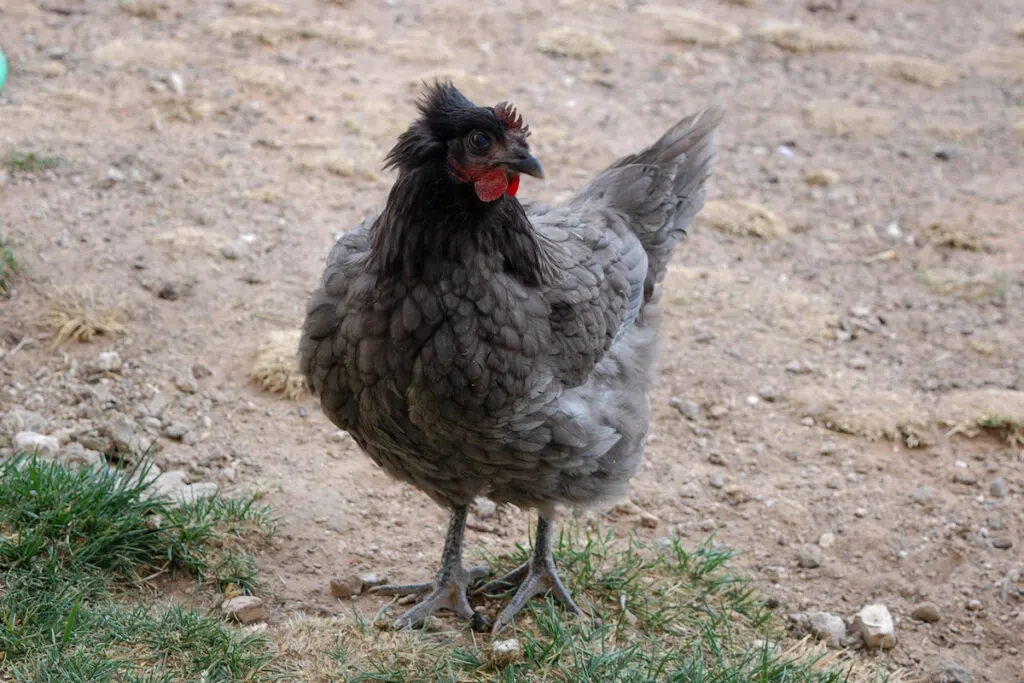In your mouth, all chickens might taste the same. But outside your mouth, all chickens are not the same. Chickens come in different breeds. They have different types of feathers, they come in different colors, and they have different sizes.
If you are thinking of the total number of chicken breeds in the world, you should count in hundreds, or perhaps thousands.

We would have loved to discuss all the chicken breeds in the world. But by the time we are done with that, almost one year would have passed, and it would be National Fried Chicken Day again. So, in this article, we shall only focus on some grey chicken breeds.
Table of Contents
Lavender Chicken Breeds
Do not be alarmed by the word “Lavender” in the subtitle, you are still on the right page. Many chickens that appear to have grey plumage are actually lavender or blue.
These chickens carry the lavender (lav) gene and the dominant black gene. The lavender gene mixes with the black gene and dilutes it to give the grey outlook.
Lavender Chickens can breed true.
Lavender Orpington
The Lavender Orpington comes from a line of chickens called Orpington. The first Orpington was the Black Orpington. This chicken breed was created by a man named William Cook.
The name Orpington? Well, that came from the name of the town he lived in – Orpington in Kent County, England.
Back in the 1800s in England, chickens were not very appealing. They looked bony and unhealthy, so William Cook set out to create an improved breed. He found success when he created the Black Orpington.
The Lavender Orpington is one of the newest breeds. They were created by Priscilla Middleton, a poultry breeder in the UK, in the mid-1900s. The Lavender Orpington has since grown in popularity across the UK, the USA, and Europe.
This breed of chickens are large, have fluffy feathers, and an upright stance, all features common to other Orpingtons. They also have 5-point medium-sized combs, they are relatively timid, and are quite tame.
The average Lavender Orpington rooster will grow to weigh about 8.5 lbs, while the hen will weigh around 6 lbs. The hens will lay about 150 – 200 eggs per year, and they lay light brown eggs.
They are tolerant of cold but avoid getting them wet. At the moment, this breed is not recognized by the American Poultry Association (APA), but this does not stop you from keeping them.
Lavender Ameracauna
The Ameracauna chicken breed comes in a range of colors including, black, blue, pale yellow, and lavender. Our focus is on the Lavender Ameracauna, even though it is not one of the colors of the breed recognized by the APA.
While Lavender Ameracaunas might have a fierce look on their face, their character is quite the opposite. They are tame, but they may not fancy when you pick them up or cuddle them.
They are tolerant of cold, and they have tiny red combs. Lavender Ameracaunas are moderate layers, and they lay about 170 – 200 eggs per year. They lay blue eggs and are usually non-broody.
At a point, it was said that the blue eggs contained low cholesterol compared to other types of eggs. But time has since unveiled that they are just like other eggs – only they look like smurfs.
On average, they live up to 8 years. Their ability to elude predators and forage contributes to their relatively long lifespan. The roosters grow to weigh 5.5 – 6.5 lbs, while the hen weighs 5.5 lbs.
This breed has its roots from Chile in the early 1900s. It was derived from another chicken breed, the Araucana.
Araucanas laid blue eggs too but carried a gene called the ET gene. When this gene was present in the parents of a chick, the chicks will die before they ever hatch.
So, to prevent the chicks’ death and retain the color of the eggs, the Araucana was crossbred. The Ameracauna (including Lavender Ameracauna) is one of the results of said crossbreeding.
Lavender Silkie
Silkies have their origins dated way back, as far back as 206 BC. It is thought to have originated from ancient China.
While Silkies are quite old, Lavender Silkies only just showed up in the early 2000s. They are not great layers. Their eggs are cream-colored and are usually not big (medium or small).
You’d be lucky to get more than 100 eggs from them per year. But they start laying ahead of most hens: around January or Late December.
In North America (the US and Canada), all Silkies are classified as bantams. But outside (such as the UK, and Australia), there are bantams and large-size silkies.
The lavender silkie is unrecognized by the APA at the moment. But about 7 other colors are recognized including, black, blue, buff, and white.
Lavender Silkies are very cuddly, gentle, and friendly. They are, however, prone to Marek’s disease. So, you should do well to get them vaccinated. In the US, the roosters weigh about 2 – 2.5 lbs, while the hens weigh 1.75 lbs – 2 lbs.
Lavender Brahma
The Lavender Brahma comes from the Brahma breed. The Brahmas find their roots tied to 2 breeds: the ‘Shanghai’ breed from China and the Grey Chittagong from the Brahmaputra River area in India.
It was reported that these 2 breeds were crossbred in the US around the mid-1800s. The Brahma breed is the outcome of this breeding, and it was refined over up to 5 decades.
Lavender Brahmas, like the other varieties of this breed, is an egg-laying and meat bird. They lay eggs predominantly during winter (usually October – March).
On average, they produce about 150 eggs per year. Now, although Lavender Brahmas are big, they are actually quite friendly, timid, and not aggressive.
You can confine them or let them forage, but they’d rather be foragers. Their thick plumage makes surviving in cold environments easy for them. The roosters weigh around 10 lbs, while the hens weigh around 8 lbs.
English Lavender Wyandotte
Being quite new, the English Lavender Wyandottes are not yet recognized by the APA. They stem from the Wyandotte breed, which was bred in America in the 1800s.
Chickens in this breed are large, and they lay around 180 – 220 eggs per year. This makes them dual-purpose.
The English Lavender Wyandotte is very rare, and they have small rose-shaped flat combs. The form of their combs makes them less prone to frostbite.
The roosters grow to weigh about 8.5 lbs, the hens grow to weigh about 6 lbs., and the bantams weigh between 3 – 3.75 lbs.
Blue Chicken Breeds
As with lavender chickens, some blue chickens have a grey appearance. They carry the blue gene and the black gene. But the blue gene dilutes the black gene making it appear grey.
Blue Chickens do not breed true.
Blue Cochin
The Blue Cochin is Asiatic, and they originate from Cochins. Cochins were noticed in the mid-1800s, and their roots are traced back to Cochinchina, a French colony that is now part of Vietnam.
The Blue Cochins look a lot less like their ancestors. The ancestral Cochin looked more like the towering Jungle Fowls. The Cochins are prettier, but they do not produce as many eggs as the ancestral breeds.
The Blue Cochins are not yet recognized by the APA, but they are recognized in the UK. They are not great layers and would usually lay between 100 – 150 eggs yearly. The good news is they are quite broody.
Blue Cochins have large bodies and a large mass of plumage. The plumage extends from their body to their feet and toes. The roosters weigh about 9 – 11 lbs, while the hens weigh 8 lbs.
They won’t do well as foragers, so keeping them confined is your best option. You are not likely to find them showing aggression. They are friendly and calm.
Blue Silkie
Blue Silkies originated from Silkies. If you’ve read through till this point, then you already know a little about Silkies. Blue Silkies are usually bantams. The roosters weigh 2 – 2.25 lbs, while the hens weigh 2 lbs.
The hens lay cream or tinted eggs, but many times they are not kept for the eggs or their meat. Blue Silkies are used as show birds, broody hens, pets, or pets.
Blue Easter Egger
The Blue Easter Eggers are thought to come from the crossbreeding of Araucanas and Amaracaunas with other breeds.
Remember we said Aracaunas and Amaracaunas lay blue eggs? Well, the outcome of crossing them with other breeds is the formation of eggs with different colors. This is why they are called Easter Eggers.
They commonly have single or pea comb, but can have any type of comb. Blue Easter Eggers are great layers with the capacity to lay up to 200 eggs per year. They might be great layers, but they are usually not broody.
They are also big enough to be used as meat. The roosters weigh about 5 lbs, while the hens weigh about 4 lbs.
Blue Easter Eggers are great foragers, but they will do well when confined too. They are non-aggressive, gentle, and friendly. They are even likely to be bullied, so keep them alongside other non-aggressive chickens.
Blue Australorp
The name Australorp is a contraction of Australian and Orpington. We already talked about Orpingtons earlier. These Orpingtons were taken to Australia and crossbred with Rhode Island Reds. The goal of this cross-breeding was to make Orpingtons better layers.
The Blue Australorp is quite rare and is famed for its ability to lay eggs even in hot weather. They lay brown eggs with a laying capacity of up to 250 eggs per year.
While the APA only recognizes the black variety, the Australian Poultry Society recognizes the blue, black, and white varieties.
Blue Australorps can live for up to 6 – 10 years. Typically, the hens weigh around 5 lbs, while the roosters weigh around 7 lbs.
Blue Plymouth Rock

The Blue Plymouth Rock is formed from breeding between the Plymouth Barred Rock and the native Andalusian. It has a great egg-laying capacity, and it is very good as meat too. It can lay up to 300 large brown eggs per year.
Blue Plymouth Rocks are recognized by the APA. They usually mature within 18 – 20 weeks, and the hens start laying eggs around the same period.
Although they are great layers, their egg-laying capacity declines after some years – usually after 3 years. They prefer to live as foragers, but they can stand confinement.
Blue Plymouth Rocks are quite gentle and friendly. Establish a trusting relationship with them, and you are sure to enjoy having them around.
They usually live for 10 – 12 years, but some can live for up to 20 years. The hens usually weigh 7.5 lbs, while the roosters weigh 9.5 lbs. Bantam varieties exist, and they typically weigh 2.5 lbs (hens) and 3 lbs (roosters).
References
- https://thechickdepot.com/products/lavender-orpington
- https://www.cacklehatchery.com/lavender-orpington-chicken.html
- https://www.thehappychickencoop.com/lavender-orpington/
- https://www.thehappychickencoop.com/ameraucana/
- https://www.cacklehatchery.com/lavender-ameraucana-chicken.html
- https://silkie.org/types-and-sizes-of-silkie-chickens.html
- https://www.thehappychickencoop.com/silkie-chicken/
- https://silkie.org/lavender-silkie-chickens.html
- https://www.thehappychickencoop.com/brahma-chicken/
- https://www.raising-happy-chickens.com/wyandotte-chickens.html
- https://thefrenchchickenshed.weebly.com/lavender-wyandotte.html
- https://www.thehappychickencoop.com/cochin-chickens/
- https://www.cacklehatchery.com/bluecochinstandard.html
- https://www.cacklehatchery.com/blue-silkie-bantam.html
- https://www.thehappychickencoop.com/easter-egger/
- https://www.welphatchery.com/layer-type-chicks/australorp-blue-female/
- https://www.thehappychickencoop.com/australorp-chickens-a-comprehensive-care-guide/
- https://www.freedomrangerhatchery.com/blue-plymouth-rock.asp
- https://www.thehappychickencoop.com/plymouth-rock-chicken/
